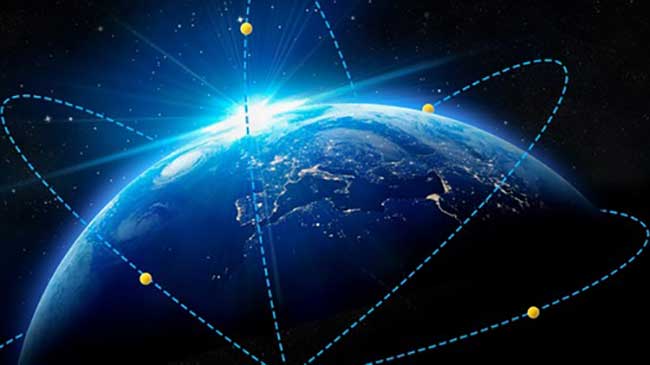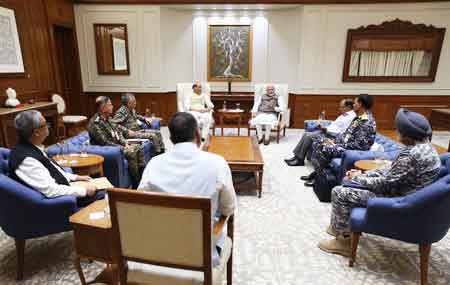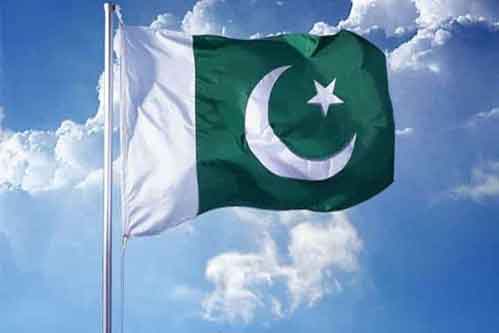Is the Indian government looking at having about 130 earth observation satellites under the public-private-partnership model, an idea mooted by the Indian National Space Promotion and Authorisation Centre (IN-SPACe) in its consultation paper?
It seems yes, based on the kind of imagery that is required and the number of revisits a satellite has to make to a particular spot, said industry experts.
The consultation paper is silent on the current revenue generated from the satellite images or the number of Indian government departments willing to invest in satellites.
"Working backwards based on the revisits and the area to be covered as mentioned in the consultation paper, there may be a need for over 100 satellites," a top official of a private satellite company told IANS preferring anonymity.
Giving further clarity on the topic was Tapan Misra, Founding Director and Chief Scientist, Sisir Radar Private Ltd and former Director at the Space Applications Centre of Indian Space Research Organisation (ISRO).
"Images with very high-resolution 30cm or better data will have a swath of 5 to 10 km. With revisit of three days, we will need 90 satellites (b) High resolution 1 metre will have a swath of 20-30 km. With a three day revisit, we need around 30 satellites and (c) stereo data of 1 metre resolution will have a revisit period of around 15 days to a month. We will need around six satellite constellations," Misra told IANS.
In other words there may be a need for about 126 or 130 earth observation satellites.
In a consultation paper on making India a geospatial hub, IN-SPACe – the regulator for private space sector players- said the PPP model could be followed whereby the private sector can build, launch and maintain earth observation satellites constellation with the Indian government being an assured customer and a funder.
Earth observation satellites are the ones that take pictures of a specified portion of the earth and send it back for infrastructure planning, achieving sustainable goals, e-governance, weather prediction, climate monitoring, disaster preparedness & mitigation and others.
One of the views on the consultation paper was without knowing the government plans how can the industry give its views on the PPP model.
"The consultation paper is seeking industry's views. It is too early to talk about revenue from the government or its satellite procurement plans," IN-SPACe Chairman Dr. Pawan Goenka had told IANS.
According to him, inputs like the government plans will be taken into consideration as the process progresses.
India's geospatial economy is expected to cross Rs 63,000 crore by 2025, growing at a rate of 12.8 per cent, and to provide employment to more than 10 lakh people, mainly through geospatial startups, IN-SPACe said.
To meet the additional requirements of the data, it is proposed to build, launch and maintain the satellite constellation, through private sector participation.
"As the Indian space industry is at its early stages, the Government of India may become an assured customer for the data, acquired through these new constellations. Public Private Partnership (PPP) model may be followed, for funding, where the NGE (non-government enterprise) participating in building EO (earth observation) Constellation & the user Government departments may jointly fund the activity. The participating industry shall clearly mention their revenue generation model," IN-SPACe said in the consultation paper.
According to it, the overall requirements are prioritised and split into three major categories (a) Very high-resolution 30cm or better data (b) High resolution 1 metre data and (c) stereo data of 1 metre resolution.
Misra said the need for about 130 satellites is based on the current situation but not taking into account the future requirements.
He said there is a need for about 300 earth observation satellites for India.
Further the Indian economy at the current pace of growth is set to become a $10 trillion economy in a decade or so.
"With growth in the economy, there comes international clout, requirement of keeping tabs on friends and enemies both within and outside, monitoring of mineral and agriculture resources, growth of infrastructure, environment and weather predictions," Misra said.
"The requirement of reconnaissance in (a) hyperspectral, multispectral, long infrared in resolution bands of 1 to 5 m (b) SAR satellites in P, L and X bands. The requirement and operations of security and civilisation purposes will be distinct. The frequency of surveillance required will be daily to weekly. Our interest will be global. We need to build 30 satellite constellations in the next ten years for each of the categories of satellites and distinct class of users like civilians and security," Misra said.
"So I foresee around 240 to 300 earth observation satellites and around 200 synthetic aperture radar (SAR) satellites in orbit in the next 10 years. Assuming an average life span of 5 years, we need to focus on capacity building of the above number with 50 per cent extra margin," Misra added.
As regards direct to satellite 5G and 6G satellites for communication, internet and internet of things application, Misra said the requirement of minimum 5,000 to 6,000 low earth communication satellites.
"Since these low earth communication satellites may be prone to jamming and anti-satellite attacks by laser or microwave beams, we need to maintain a global inventory of around 60 to 100 high throughput satellites (HTS) in GSO, with global coverage as strategic back up. We also need around 30 satellites in the geostationary orbit (GSO) for global weather prediction, constant land and ocean surveillance as strategic deterrence," Misra remarked.






Operation Sindoor: PM Modi meets Rajnath Singh, NSA Doval and three service chiefs
In the backdrop of the ongoing ‘Operation Sindoor’, Prime Minister Narendra Modi chaired a high-level meeting attended by Defence Minister Rajnath Singh, National Security Advisor Ajit Doval, Chief of Defence Staff General Anil Chauhan, and Chiefs of the Armed Forces and senior officials.
11 more Bangladeshi nationals held in Tripura
The Tripura Frontier of the Border Security Force (BSF), jointly with state police, on Friday apprehended 11 more Bangladeshi nationals, including four women and four children, officials said.
Railway Protection Force tightens security in NFR zone
In response to escalating security challenges across the country, Railway Protection Force (RPF) of the Northeast Frontier Railway (NFR) has significantly strengthened its security protocols at stations, trains and railway premises, an official said on Friday.
India opposes IMF lifeline for Pakistan due to terror financing risk
India strongly opposed further financial assistance from the IMF to Pakistan at the executive board meeting held on Friday, expressing serious concerns over Islamabad’s track record and the fact that the bailouts were enabling the cash-strapped country to sponsor cross-border terrorism.
Sirens echo across Jammu as 'blasts' trigger blackout; CM Omar Abdullah posts urgent advisory on social media
Jammu city plunged into darkness late Friday evening after a series of blasts were heard across the region, prompting authorities to sound emergency alarms and urge citizens to stay indoors.
Enough rice, wheat, sugar, oil and pulses stock, no need to panic: Pralhad Joshi
The government on Friday reiterated that there is no shortage of essential commodities in the country, and citizens are advised not to panic or rush to the markets to purchase food grains.
Indian carriers cancel flights to 24 airports till May 15 as tensions flare up
Indian carriers on Friday announced that flights to 24 airports had been cancelled till May 15, following a notification from aviation authorities on the continued closure of multiple airports in the country.
New low even for Pakistan: India hits out at Islamabad for targetting religious places
As Pakistani troops continued resorting to heavy mortar shelling on the Indian side along the Line of Control (LoC), India on Friday slammed the rogue nation for specifically targetting religious places labelling it as a "new low even for Pakistan".